
Berberis aquifolium, the Oregon grape or holly-leaved barberry, is a species of flowering plant in the family Berberidaceae, native to western North America. It is an evergreen shrub growing 1–3 meters tall and 1.5 m (5 ft) wide, with pinnate leaves consisting of spiny leaflets, and dense clusters of yellow flowers in early spring, followed by dark bluish-black berries.

Mahonia is a formerly accepted genus of approximately 70 species of shrubs or, rarely, small trees with evergreen leaves in the family Berberidaceae, native to eastern Asia, the Himalaya, North America, and Central America. They are closely related to the genus Berberis and as of 2023 the majority of botanical sources list it as a synonym for Berberis.

Berberis, commonly known as barberry, is a large genus of deciduous and evergreen shrubs from 1–5 m (3.3–16.4 ft) tall, found throughout temperate and subtropical regions of the world. Species diversity is greatest in South America and Asia; Europe, Africa and North America have native species as well. The best-known Berberis species is the European barberry, Berberis vulgaris, which is common in Europe, North Africa, the Middle East, and central Asia, and has been widely introduced in North America. Many of the species have spines on the shoots and all along the margins of the leaves.
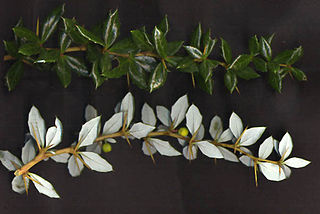
Berberis verruculosa, the warty barberry or warted barberry, is an evergreen shrub, ranging in size from 1–2 m, native to western China. It gets its common name from its "warty" stems, that have rounded, more or less identical, raised spots.

Berberis microphylla, common name box-leaved barberry and Magellan barberry, in Spanish calafate and michay and other names, is an evergreen shrub, with simple, shiny box-like leaves. The calafate is native to southern Argentina and Chile and is a symbol of Patagonia. Berberis microphylla should not be confused with Mahonia microphylla, native to China.

Berberis darwinii, Darwin’s barberry, is a species of flowering plant in the family Berberidaceae, native to southern Chile and Argentina and naturalized elsewhere. Regional vernacular names include michay, calafate, and quelung. Growing to 3–4 m (9.8–13.1 ft) tall, it is an evergreen thorny shrub.
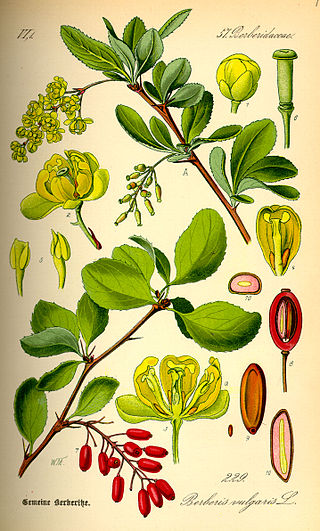
Berberis vulgaris, also known as common barberry, European barberry or simply barberry, is a shrub in the genus Berberis native to the Old World. It produces edible but sharply acidic berries, which people in many countries eat as a tart and refreshing fruit.

Berberis thunbergii, the Japanese barberry, Thunberg's barberry, or red barberry, is a species of flowering plant in the barberry family Berberidaceae, native to Japan and eastern Asia, though widely naturalized in China and North America, where it has become a problematic invasive in many places, leading to declines in species diversity, increased tick habitat, and soil changes. Growing to 1 m tall by 2.5 m broad, it is a small deciduous shrub with green leaves turning red in the autumn, brilliant red fruits in autumn and pale yellow flowers in spring.

Berberis candidula is a species of plant in the family Berberidaceae. It is endemic to China, native to the provinces of Hubei and Sichuan. It is commonly known as paleleaf barberry.

Berberis oiwakensis is a species of plant in the barberry family, Berberidaceae. It is native to Taiwan, China and Myanmar, where it occurs at elevations of 600 to 3800 m. It has recently been found naturalized in South Africa.

Berberis japonica is a species of flowering plant in the family Berberidaceae, native to Taiwan. Despite the name, it is not native to Japan, though it has been known in cultivation there for centuries. The wild origins of this species have long puzzled botanists, but wild plants in Taiwan, previously known under the name Mahonia tikushiensis, appear most similar to the cultivated forms of B. japonica.

Berberis valdiviana is a species of flowering plant in the barberry family Berberidaceae. It is an evergreen shrub from Chile, where it is locally known as cien or espina en cruz. The Latin specific name valdiviana refers to the Valdivia Province of Chile. It has simple, dark green, pointed leaves, glossy on the upper surfaces, up to 8.5 cm (3.3 in) long. The flowers, which appear in May, are grouped in hanging racemes. Individual flowers are orange, 5–8 mm (0.2–0.3 in) across, and are followed by purplish fruits. It is grown as an ornamental plant, but is not suitable for colder regions.
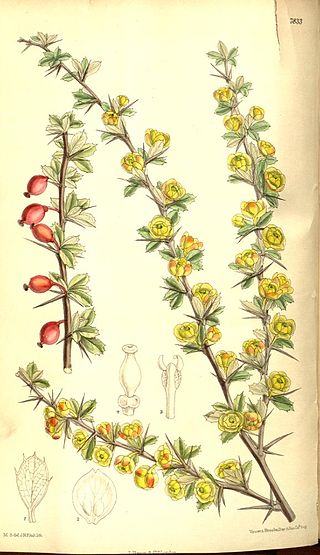
Berberis dictyophylla, the netleaf barberry, is a deciduous shrub in the genus Berberis which is native to Western China.
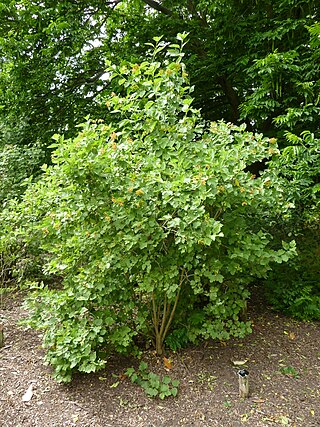
Viburnum sargentii is a species of flowering plant in the family Adoxaceae, native to north eastern Asia. Growing to 3 m (10 ft) tall and broad, it is a substantial deciduous shrub with 3-lobed, maple-like leaves, often turning red in autumn. Flat white flower-heads (cymes) resembling those of lacecap hydrangeas are borne in early summer. The outer florets are saucer-shaped and sterile, while the central tubular flowers are fertile. The flowers are followed in autumn by globose red berries.
Berberis aemulans is a shrub endemic to the region of Sichuan in southern China. It grows there in thickets and on slopes at elevations of 2900–3200 m.

Berberis veitchii is a shrub native to western Hubei, China. It was once cultivated as an ornamental in other countries, the source almost certainly being seed collected by Wilson..

Berberis dictyota, now reclassified as Berberis aquifolium var. dictyota, with the common names Jepson's oregon grape and shining netvein barberry, is a flowering plant in the Barberry family.

Berberis amurensis, commonly known as Amur barberry, is a shrub native to Japan, Korea, the Russian Far East, and parts of China. It is named for the Amur River, which forms part of the boundary between Russia and China. It is found at elevations of 1100–2900 m.

Berberis bealei, also known as leatherleaf mahonia, Beale's barberry, is a species of evergreen shrub native to mainland China. The species has been regarded as the same species as Berberis japonica, native to Taiwan, but the two differ consistently in certain floral and leaf characters. Both species are widely cultivated in many countries as ornamentals. Berberis bealei has reportedly escaped cultivation and become established in the wild in scattered places in the south-eastern United States from Arkansas to Florida to Delaware.
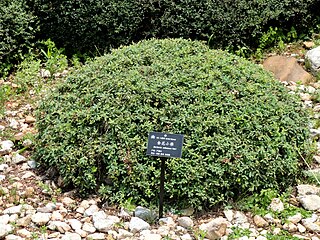
Berberis wilsoniae, Mrs. Wilson's barberry, is a species of flowering plant in the family Berberidaceae. It is native to Tibet, south-central China, and Myanmar, and has been introduced to the North and South Islands of New Zealand. It is a mound-forming, deer-resistant shrub, with blueish-green leaves that turn red in Autumn and yellow flowers that produce translucent pink fruit. A number of cultivars are available.


















